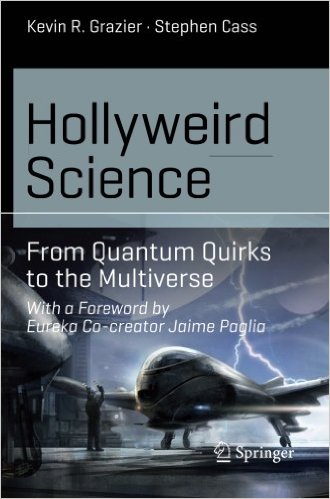
Dr. Kevin Grazier has made a career of studying intergalactic planetary formation, and, over the last few years, helping Hollywood writers integrate physics smartly into storylines for popular TV shows like Battlestar Galactica, Eureka, Defiance and the blockbuster film Gravity. His latest book, Hollyweird Science: From Quantum Quirks to the Multiverse traverses delightfully through the science-entertainment duality as it first breaks down the portrayal of science in movies and television, grounding the audience in screenplay lexicon, then elucidates a panoply of physics and astronomy principles through the lens of storylines, superpowers and sci-fi magic. With the help of notable science journalist Stephen Cass, Hollyweird Science is accessible to the layperson sci-fi fan wishing to learn more about science, a professional scientist wanting to apply their knowledge to higher-order examples from TV and film or Hollywood writers and producers of future science-based materials. From case studies, to in-depth interviews to breaking down the Universe and its phenomena one superhero and far-away galaxy at a time, this first volume of an eventual trilogy is the essential foundation towards understanding how science is integrated into a story and ensuring that future TV shows and movies do so more accurately than ever before. Full ScriptPhD review and podcast with author and science advisor Dr. Grazier below.
Most people who watch movies and TV shows never went to film school. They are not familiar with the intricacies of three-act structure, tropes, conceits and MacGuffins that are the skeletal framework of a standard storytelling toolkit. Yet no genre is more rooted in and dependent on setup and buying into a payoff than sci-fi and films conceptualized in scientific logic. Many, if not most, critiques of science in entertainment don’t fully acknowledge that integrating abstruse science/technology with the complex constraints of time, length, character development and screenplay format is incredibly demanding. Hollyweird Science does point out some egregious examples of “information pollution” and the “Hollywood Curriculum Cycle” – the perpetuation bad, if not fictitious, science. But after grounding the reader in a primer of the fundamental building blocks of movie-making and TV structure, not only is there a more positive, forgiving tone in breaking down the history of the sci-fi canon (some of which predicted many of the technological gadgets we enjoy today), but even a celebration of just how much and how often Hollywood gets the science right.
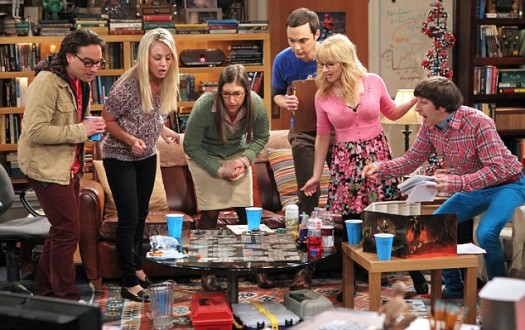
Conversely, the vast majority of Hollywood writers, producers and directors don’t regularly come across PhD scientists in real life, and have to form impressions of doctors, scientists and engineers based on… other portrayals in entertainment. Scientists, after all, represent only 0.2 percent of the U.S. population as a whole, and less than 700,000 of all jobs belong to doctors and surgeons. And while these professions are amply represented on screen in number, that’s not necessarily been the case in accuracy. The insular self-reliance of screenwriters on their own biases has led to stereotyping and pigeonholing of scientists into a series of familiar archetypes (nerds, aloof omniscient sidekicks), as Grazier and Cass take us through a thorough, labyrinthine archive of TV and movie scientists. But as scientists have become more involved in advising productions, and have become more prominent and visible in today’s innovation-driven society, their on screen counterparts have likewise become a more accurate reflection of these demographics – mainstream hits like The Big Bang Theory, CSI (and its many procedural spinoffs), Breaking Bad and films like Gravity, The Martian, Interstellar and The Imitation Game are just a recent sampling.
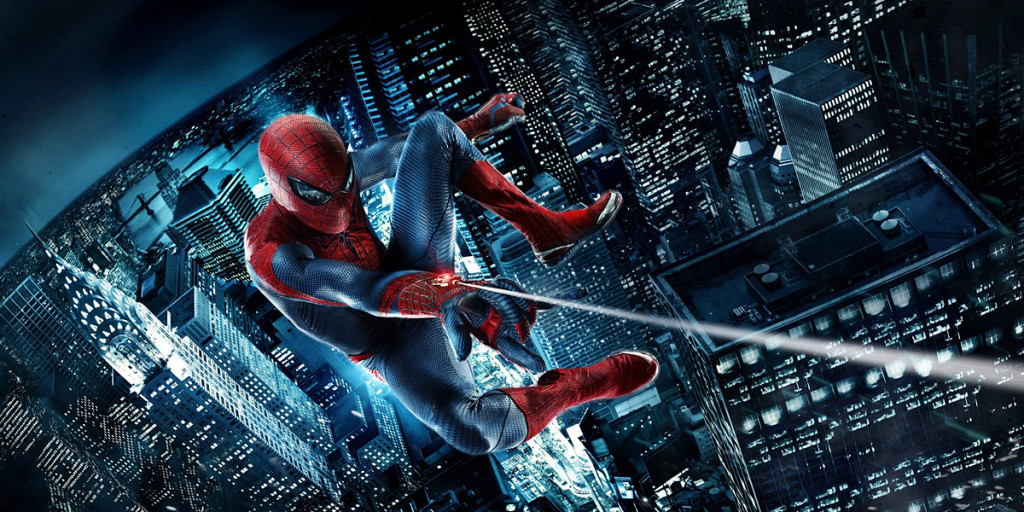
If you’re going to teach a diverse group of readers about the principles of physics, astronomy, quantum mechanics and energy forms, it’s best to start with the basics. Even if you’ve never picked up a physics textbook, Hollyweird Science provides a fundamental overview of matter, mass, elements, energy, planet and star formation, time, radiation and the quantum mechanics of universe behavior. More important than what these principles are, Grazier discerns what they are not, with running examples from iconic television series, movies and sci-fi characters. What exactly is the difference between weight and mass and force, per the opening scene of the film Gravity? How are different forms of energy classified? Are the radioactive giants of Godzilla and King Kong realistic? What exactly happens when Scotty is beamed up? Buoying the analytical content are a myriad of interviews with writers and producers, expounding honestly about working with scientists, incorporating science into storytelling and where conflicts arose in the creative process.
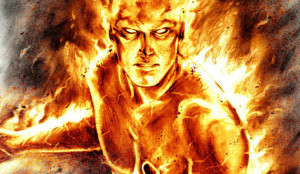
People who want to delve into more complex science can do so through “science boxes” embedded throughout the book – sophisticated mathematical and physics analyses of entertainment staples, trivial and significant. Among my favorites: why Alice in Wonderland is a great example of allometric scaling, the thermal radiation of cinematography lighting, hypothesizing Einsteinian relativity for the Back To The Future DeLorean, and just how hot is The Human Torch in the Fantastic Four? (Pretty dang hot.)
The next time readers see an asteroid making a deep impact, characters zipping through interplanetary travel, or an evil plot to harbor a new form of destructive energy, they’ll have a scientific foundation to ask simple, but important, questions. Is this reasonable science, rooted in the principles of physics? Even if embellished for the sake of advancing a story, could it theoretically happen? And for Hollywood writers, how can science advance a plot or help a character solve their connundrum? In our podcast below, Dr. Grazier explains why physics and astronomy were such an important bedrock of the first book – and of science-based entertainment – and previews what other areas of science, technology and medicine future sequels will analyze.
In the long run, Hollyweird Science will serve as far more than just a groundbreaking book, regardless of its rather seamless nexus between fun pop culture break-down and serious scientific didactic tool. It’s a part of a conceptual bridge towards an inevitable intellecutal alignment between Hollywood, science and technology. Over the last 10-15 years, portayal of scientists and ubiquity of science content has increased exponentially on screen – so much so, that what was a fringe niche even 20 years ago is now mainstream and has powerful influence in public perception and support for science. Science and technology will proliferate in importance to society, not just in the form of personal gadgets, but as problem-solving tools for global issues like climate change, water access and advancing health quality. Moreover, at a time when Americans’ grasp of basic science is flimsy, at best, any material that can repurpose the universal love of movies and television to impart knowledge and generate excitement is significant. We are at the precipice of forging a permanent link between Hollywood, science and pop culture. The Hollyweird series is the perfect start.
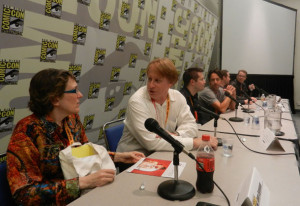
In an exclusive podcast conversation with ScriptPhD.com, Dr. Grazier discussed the overarching themes and concepts that influenced both “Hollyweird Science” and his ongoing consulting in the entertainment industry. These include:
•How the current Golden Age of sci-fi arose and why there’s more science and technology content in entertainment than ever
•Why scientists and screenwriters are remarkably similar
•Why physics and astronomy are the building blocks of the majority of science fiction
•How the “Hollyweird Science” trilogy can be used as a didactic tool for scientists and entertainment figures
•His favorite moments working both in science and entertainment
*****************
ScriptPhD.com covers science and technology in entertainment, media and advertising. Hire our consulting company for creative content development. Follow us on Twitter and Facebook. Subscribe to our podcast on SoundCloud or iTunes.
As part of an ongoing recommitment to its sci-fi genre roots, SyFy Channel is unveiling the original scripted drama Ascension, for now a six hour mini-series, and possible launch for a future series. It follows a crew aboard the starship Ascension, as part of a 1960s mission that sent 600 men, women and children on a 100 year planned voyage to populate a new world. In the midst of political unrest onboard the vessel, the approach of a critical juncture in the mission and the first-ever murder onboard the craft, the audience soon learns, there is more to the mission than meets the eye. Which can also be said of this multi-layered, ambitious, sophisticated mini-series. Full ScriptPhD review below.

In the late 1950s and early 1960s, largely fueled by the heigh of Cold War tensions with the Soviet Union and fears of mutual nuclear destruction, the United States government, in conjunction with NASA, launched a project that would have sent 150 people into various corners of space — from the Moon, to Mars and eventually Saturn. Code-named Orion, the project officially launched in 1958 at General Atomics in San Diego under the leadership of nuclear researcher Frederick deHoffman, Los Alamos weapons specialist Theodore Taylor and theoretical physicist Freeman Dyson. Largely fueled by Dyson, Orion’s aim was to build a spacecraft equipped with atomic bombs, that would propel the rocket further and further into space through a series of well-timed explosions (nuclear propulsion). The partial test ban treaty of 1963 ended the grandiose project, which remains classified to this day.
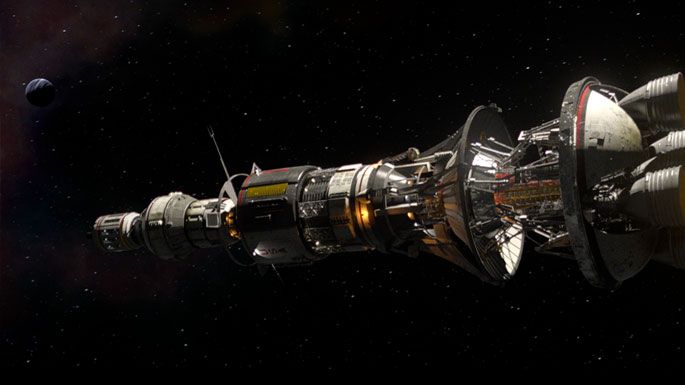
Ascension is the seamless fictional transition borne of asking “what if” questions about the erstwhile Project Orion. What if it never ended? What if it was still ongoing? What would be the psychological ramifications of entire generations of people born, raised and living on a closed vessel? Is human habitation of other planets an uncertainty or inevitability? And so Project Orion continued on as Project Ascension, under the hands of Abraham Enzmann. A crew of 600 was sent off into space not knowing the fate of humanity, frozen in time, and as far as they know — all that would be left of mankind.
Ascension carries on in the vein of stylish series such as Caprica, Helix and Defiance, with sleek sci-fi gadgetry and a spaceship capable of mimicking an entire world (including a beach!) for 100 years. This is no dilapidated, aging Battlestar Galactica. However, because time is frozen in the 1960s, all technology, clothes and cultural collections reflect that era — think Mad Men in space. Nostalgia reigns with references to the Space Race via speeches from President Kennedy, along with film and television cornerstones of that era.
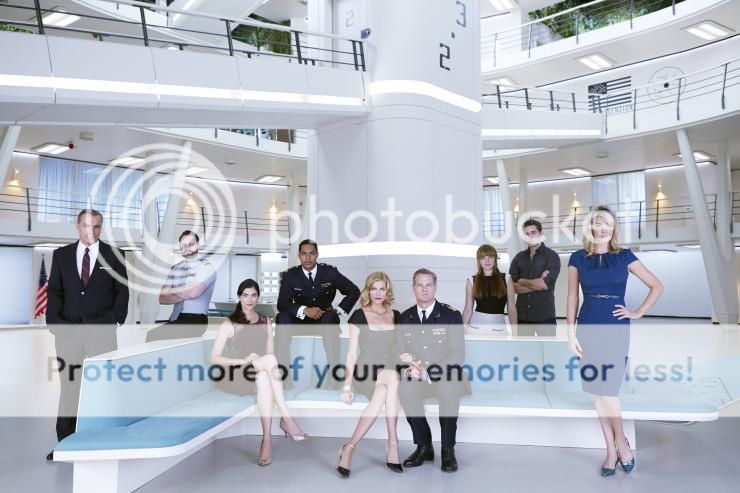
51 years into the mission, on the evening of the annual launch party celebration, a kind of Ascension independence day, the unthinkable happens: the first ever murder onboard the ship. Captain William Denninger puts first officer Aaron Gault in charge of investigating. Soon, the motives for the murder become convoluted amidst internal politics and the looming “Insurrection,” a point of no return in which communication with Earth is no longer possible.
This year’s space epic Interstellar explored the science of traveling 10 billion light years away from Earth – ambitiously but not without factual fault. And to be sure, Ascension will address the challenges and physics of nuclear propulsion to the far reaches of space, starting with a radiation storm midway through the first episode. But rather than bogging itself down in the astrophysical minutiae of space travel, Ascension smartly focuses on the human drama and existential questions such a voyage would incur, precisely what made Battlestar Galactica such compelling sci-fi television. Would there be internal psychological ramifications to this journey? All residents of the ship seem to go through an adolescent period termed “The Crisis,” where they come to grips with the fact that they have no future, and a pre-determined fate. Furthermore, the murder victim’s young sister appears to be a “seer” with telekinetic insight into the nefarious inner workings of the ship.
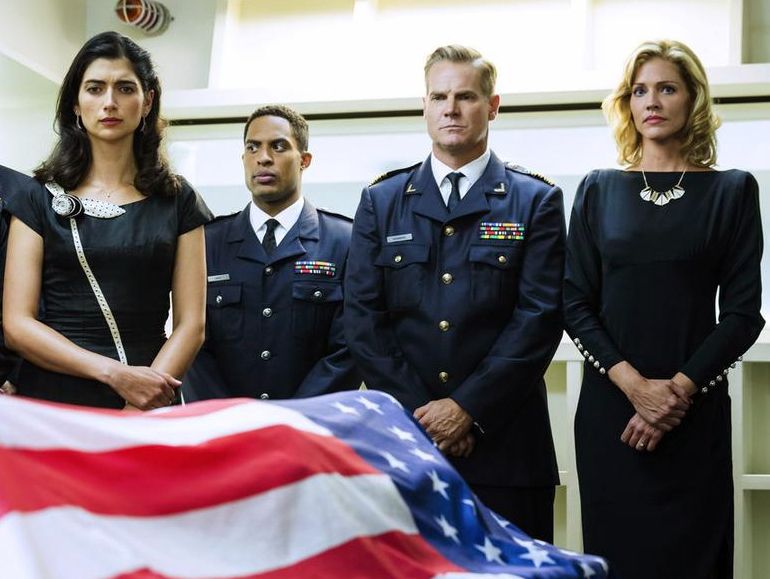
Would there be class division and political turmoil aboard such a confined community? There is a decidedly troublesome rift between the ranking officers of the upper quarters and the “Below Deckers”: butchers, steelworkers and other blue-collar craftsmen that appear on the edge of a revolt. Compounding their efforts are the Captain’s wife, Viondra Denninger (whom fans will recognize as Cylon Number Six from BSG), a cunning, manipulative power broker and the man seeking to wrestle control of the ship from her husband. Back on Earth, we meet Harris Enzmann, the son of the dying Project Ascension founder. Seemingly a low level government engineer, nor remotely interested in preserving his father’s legacy, his role in Project Ascension is convoluted yet significant.
Project Ascension is indeed an experiment critical for human survival — just not the one anyone onboard thinks it is. Amidst an awakened collective imagination about space exploration, including 2015’s IMAX Mars mission movie Journey To Space, this is one sci-fi mission worth taking.
View a trailer for Ascension:
Ascension is a three-day mini-series event on SyFy Channel, beginning Monday, December 15.
~*ScriptPhD*~
*****************
ScriptPhD.com covers science and technology in entertainment, media and advertising. Hire us for creative content development.
Subscribe to free email notifications of new posts on our home page.
]]>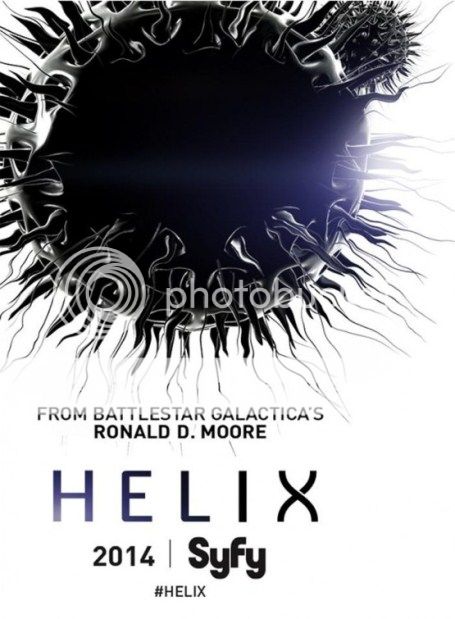
The biggest threat to mankind may not end up being an enormous weapon; in fact, it might be too small to visualize without a microscope. Between global interconnectedness and instant travel, the age of genomic manipulation, and ever-emerging infectious disease possibilities, our biggest fears should be rooted in global health and bioterrorism. We got a recent taste of this with Stephen Soderberg’s academic, sterile 2011 film Contagion. Helix, a brilliant new sci-fi thriller from Battlestar Galactica creator Ronald D. Moore, isn’t overly concerned with whether the audience knows the difference between antivirals and a retrovirus or heavy-handed attempts at replicating laboratory experiments and epidemiology lectures. What it does do is explore infectious disease outbreak and bioterrorism in the greater context of global health and medicine in a visceral, visually chilling way. In the world of Helix, it’s not a matter of if, just when… and what we do about it after the fact. ScriptPhD.com reviews the first three episodes under the “continue reading” cut.
The benign opening scenes of Helix take place virtually every day at the Centers for Disease Control, along with global health centers all over the world. Dr. Alan Farragut, leader of a CDC outbreak team, is assembling and training a group of researchers to investigate a possible viral outbreak at a remote research called Arctic Biosystems. Tucked away in Antarctica under extreme working conditions, and completely removed from international oversight, the self-contained building employs 106 scientists from 35 countries. One of these scientists, Dr. Peter Farragut, is not only Alan’s brother but also appears to be Patient Zero.

It doesn’t take the newly assembled team long to discover that all is not as it seems at Arctic Biosystems. Deceipt and evasiveness from the staff lead to the discovery of a frightening web of animal research, uncovering the tip of an iceberg of ‘pseudoscience’ experimentation that may have led to the viral outbreak, among other dangers. The mysterious Dr. Hiroshi Hatake, the head of Ilaria Corporation, which runs the facility, may have nefarious motivations, yet is desperately reliant on the CDC researchers to contain the situation. The involvement of the US Army engineers and scientists, culminating in a shocking, devastating ending to the third episode, hints that the CDC doesn’t think the outbreak was accidental. Most frightening of all is the discovery of two separate strains of the virus, Narvic A and Narvic B, the former of which turns victims into a bag of Ebola-like hemorrhagic black sludge, while the latter rewires the brain to create superhuman strength – a perfect contagion machine.
With some pretty brilliant sci-fi minds orchestrating the series, including Moore, Lost alum Steven Maeda and Contact producer Lynda Obst, it’s not surprising that Helix extrapolates extremely accurate and salient themes facing today’s scientific environment. Spot on is the friction between communication and collaboration between the agencies depicted on the show – the CDC, bioengineers from the US Army and the fictional Arctic Biosystems research facility. In reality, identifying and curtailing emerging infectious disease outbreaks requires a network of collaboration among, chiefly, the World Health Organization, the CDC, the US Army Medical Research Institute of Infectious Diseases (USAMRIID, famously portrayed in the film Outbreak) and local medical, research and epidemiological outposts at the outbreak site(s). In addition to managing egos, agencies must quickly share proprietary data and balance global oversight (WHO) with local and federal juristictions, which can be a challenge even under ordinary conditions. To that extent, including a revised set of international health regulations in 2005 and the establishment of an official highly transimissible form of the virus created a hailstorm of controversy. In addition to a publishing moratorium of 60 days and censorship of key data, debate raged on the necessity of publishing the findings at all from a national security standpoint and the benefit to risk value of such “dual-use” research. Similar fears of “playing God” were stoked after the creation of a fully synthetic cell by J. Craig Venter and the team behind the Genome Project.

As with Moore’s other SyFy series, Battlestar Galactica, Helix is not perfect, and will need time and patience (from both the network and viewing audience) to strike the right chemistry and develop evenness in its storytelling. The dialogue feels forced at times, particularly among the lead characters and with rapid fire high-level scientific jargon, of which there is a surprising amount. Certain scenes involving the gruesomeness of the viruses feel too long and repetitive in the first episodes, but this will quickly dissipate as the plot develops. But for all of its minor blemishes, Helix is one of the smartest scientific premises to hit television in recent times, and looks to deftly explore familiar sci-fi themes of bioengineering ethics and the risks of ‘playing God’ just because we have the technology to do so.
We’ve become accustomed to sci-fi terrifying us visually, such as the ‘walker’ zombies of The Walking Dead or even psychologically, as in the recent hit movie Gravity. But Helix’s terror is drawn from the utter plausibility of the scenario it presents.
View an extended 15 minute sample of the Helix pilot here:
Helix will air on Friday nights at 10:00 PM ET/PT on SyFy channel.
~*ScriptPhD*~
*****************
ScriptPhD.com covers science and technology in entertainment, media and advertising. Hire us for creative content development.
Subscribe to free email notifications of new posts on our home page.
]]>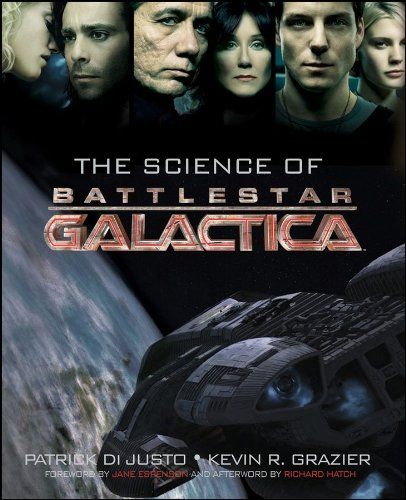
Battlestar Galactica is one of the defining, genre-changing science fiction shows of its, or perhaps any, time. The remake of the 1970s cult classic was sexy, sophisticated, and set a new standard for the science fiction shows and movies that will follow in its path. In addition to exploring staple concepts such as life, survival, politics and war, BSG reawakened its audience to science and its role in moral, ethical, and daily impact in our lives, especially given the technologically-driven era that we live in. “Writers were not allowed to jettison science for the sake of the story,” declares co-executive producer Jane Espenson in her foreword to the book. “Other than in specific instances of intentionally inexplicable phenomena, science was respected.” In an artful afterword, Richard Hatch (the original Apollo and Tom Zarek in the new series) concurs. “BSG used science not as a veneer, but as a key thematic component for driving many of the character stories… which is the art of science fiction.” The sustained use of complex, correct science as a plot element to the degree that was done in Battlestar Galactica is also a hallmark first. This is the topic of the new book The Science of Battlestar Galactica, newly released from Wiley Books, and written by Kevin R. Grazier, the very science advisor who consulted with the BSG writing staff on all things science, with a contribution from Wired writer Patrick DiJusto. Now, for the first time, everyone from casual fans to astrophysicists can gain insight into the research used to construct major stories and technology of the show—and learn some very cool science along the way. Our review of The Science of Battlestar Galactica (and our 100th blog post!) under the “continue reading” cut.
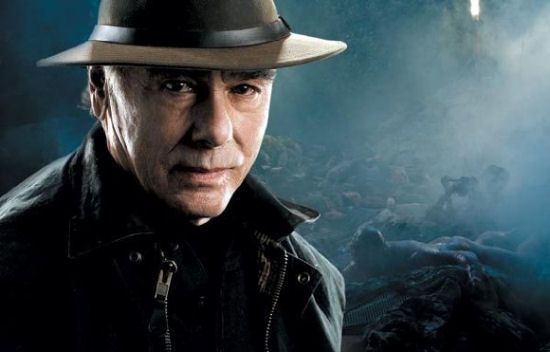
What is life? Seriously. I’m not asking one of those hypothetical existential questions that end up discussed ad nauseum in a dorm room at 3 AM. I’m asking the central question that Battlestar Galactica, and much of science fiction, is based around. The shortest section of The Science of Battlestar Galactica, “Life Began Out Here,” is its most poignant. No matter the conflict, subplot or theme explored on BSG, they ultimately reverted back to the idea of what constituted a living being, and what rights, if any, those beings possessed. It all boils down to cylons. What are they made of? How do their brains (potentially) work? How much information can they contain, and how is it processed from one dead cylon to its next incarnation? How could a cylon and a human mate successfully, and is their offspring (Hera Agathon) the Mitochondrial Eve of that society? How did they evolve? What is the biological difference between raiders, centurions, and humanoid cylons? Who can forget the ew gross factor of Boomer plugging her arm into the cylon computer system, but how could she do that, especially when she was made to act, feel and think as a human being? A brief, smart discussion on spontaneous evolution and basic biology gives way to a thoughtful evocation of our own efforts with artificial intelligence, and the responsibilities that it engenders. Take a look at the website of the MIT iGem Program, an annual competition to design biological systems that will operate in living cells from standard toolkits. Do some of their creations, including bacteria that eat industrial pollutants and treat lactose intolerance, constitute life, and are our own Cybernetic Life Nodes not too far away? The section ends in a fascinating debate over who we are more akin to—the humans of the Battlestar universe (as is widely assumed) or cylons. The answer would surprise you.
The middle of The Science of Battlestar Galactica, composed of “The Physics of Battlestar Galactica” and “The Twelve Colonies and The Rest of Space” reads largely like my college physics textbook, only with far cooler sample problems. If Apollo and Starbuck both launch their vipers at the same time and Starbuck coasts past Apollo, according to special relativity, who is moving? In perhaps the greatest implementation of Einstein’s famous theory in science fiction, special relativity explains how Starbuck could explain that she wasn’t a Cylon when she returned unharmed from the dead, and why her viper looked brand new. A special look at radiation particularly interested me, with a chemistry background, as it thoroughly delved into the chemistry and physics of radiation, heat-seeking missile weapons, DNA damage, and the power of nuclear weapons, both with fictional examples (the destruction of Caprica) and real (Japan and Chernobyl). The chapters on relativity (E=mc2) and the Lorentz Contraction reminded me of a seminar on dark energy that we covered at the Hollywood Laserium presented a year ago by Dr. Charles Baltay (NOT Baltar!), the man who was responsible for Pluto losing its planetary status. At the time, a lot of the concepts seemed a bit esoteric, but having read this book, are now elementary. Did you know, for example, that a supernova explosion is so powerful, it can briefly cause iron and other atoms remaining in the star to fuse into every naturally occurring element in the periodic table? Nifty, eh? Astronomy buffs, amateur and experienced, will enjoy the section on space, with a preamble on the formation of our galaxy and star systems to the 12 different planets of the Colonies, and how that many habitable planets could all be packed into such a dense area (see companion map below).
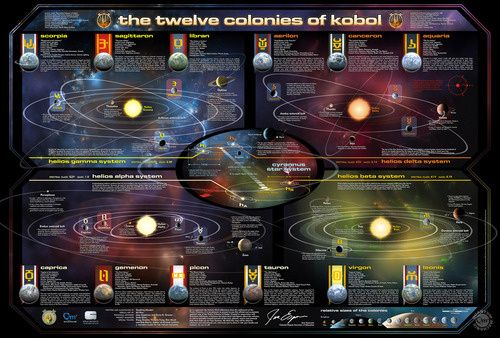
With perfect timing for the publication of The Science of BSG, Kevin R. Grazier and co-executive producer Jane Espenson have teamed up to create a plausible astronomy map of the 12 colonies of Battlestar Galactica. Find a larger, interactive version here.

One of the more fun aspects to watching BSG was the cornucopia of weapons, toys, and other electronics used by both humans and Cylons, a subject explored in the most meaty section of the whole book, “Battlestar Tech.” This includes a discussion of propulsion and how the Galactica’s jump drive might work, artificial gravity, a great chapter on the vipers and raptors as effective weapons, and positing how it is that Six was able to infiltrate the colonial computer infrastructure… besides the obvious, that is. I really enjoyed learning about Faraday cages, tachyon particles, brane cosmology, and what a back door is in computer programming, terms you can bet I will be throwing out casually at my next hoity-toity dinner party. The next time you rewatch an episode, and hear Mr. Gaeta utter a directive such as “We have a Cylon raider, CBDR, bearing 123 carom 45,” not only will you know exactly what he’s saying relative to the cartesian coordinates of the BSG space universe, but how this information is used to operate the complicated three-dimensional space system that the pilots have to operate in. Finally, critics such as myself of the dilapidated corded phones used aboard the Galactica will be interested to find out why they may have actually been a good idea in protecting the fleet from Cylon detection.
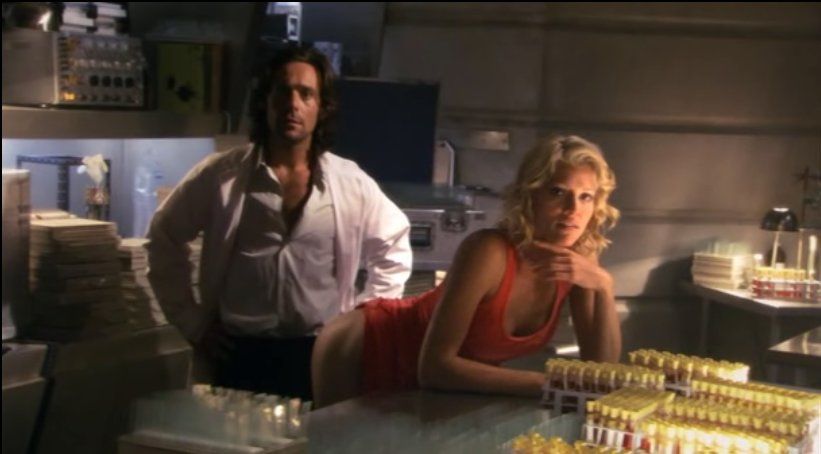
The ultimate selling point of this book is its ability to present material that will appeal to all fractions of a very diverse audience. The writing style is fluid, clever, informative and appropriately humorous in the way one would expect of a geeky sci-fi book (highlighted by a chapter on Cylon composition and detection thereof by Dr. Baltar written in dialogue format between an omniscient scientist and a smart-aleck fanboy). In fact, the co-authors merge their styles well enough so as to imagine that only one person wrote the book. Part textbook, part entertainment, part series companion, The Science of Battlestar Galactica is concomitantly smart, complicated, approachable and difficult—it does not surprise us one bit that in the couple of short months since its wide release, talk of numerous literary awards has already been circling. In between lessons on basic biology, astrophysics, energy and basic engineering are sprinkled delightful vignettes of actual on-set problem solving involving science. My favorites included plausible ways Cylons could download their information as they’re reborn (get ready for some serious computer-speak here!), an excellent explanation of Dr. Baltar’s mysterious Cylon detector, radiation and the difference between uninhabitable ‘dead Earth’ and barely habitable New Caprica, and the revelation by Dr. Grazier of how he had to—in a frantic period of 24 sleepless hours—construct a theory as to how the FTL drive works for an episode-specific reason. Much like the show it is based on, this book asks as many questions as it answers, most notably on social parables within our own world. Are we on our way to building Cylon artificial intelligence? Could our computer infrastructure ever get compromised like the ones on Caprica? Would we ever be able to travel to parallel universes, and what would be the implications of life forms besides our own? How might they even detect our presence?
Read our in-depth interview with Kevin R. Grazier here
Join our our Facebook fan page for a special giveaway commemorating the release of The Science of Battlestar Galactica and our 100th blog post. Now if you’ll excuse me, having read and absorbed this illuminating volume, I have been inspired to go and watch the entire series from start to finish all over again!
~*ScriptPhD*~
*****************
ScriptPhD.com covers science and technology in entertainment, media and advertising. Hire our consulting company for creative content development.
Subscribe to free email notifications of new posts on our home page.
]]>
Day 2 of Comic-Con is over and now, the Convention is really underway! Today’s ScriptPhD.com coverage has a heavy focus on television, and sci-fi television to be specific. Really, is there any other kind? We spent time in the press room with the stars and producers of SyFy Channel hits Caprica and Stargate Universe, our favorite geeky physics show Big Bang Theory and the exciting (first-time ever!) Comic-Con Discovery Channel unveiling of their new scripted series Reign of the Dinosaurs. As always we try to pay hommage to the roots of Comic-Con with coverage of the design tricks behind comics and graphic novels. Additionally, we provide pictorial documentation of the costumes and happenings of the Con, and our Day 2 Costume of the Day. Complete coverage under the “continue reading” cut.
From the Press Room: Stargate Universe
We were delighted to start our day with the cast of one of our favorite sci-fi shows on the air, Stargate Universe, to get a little peek into the cast’s geeky sides and what they think of their characters and show.

For star David Blue, playing the ship’s resident math geek Eli Wallace, this year is a completely different experience. Last year, there was so much uncertainty about the show’s acceptance and success, while this year, the cast walks into Comic-Con confident of where they are headed. He spoke of liking the idea of Eli as a hero, the show’s surrogate for the audience. Though he admits to being a geek, he was very hesitant to play the role when he heard about it, because of his previous computer nerd role on Moonlight for fear of typecasting. But Eli is not a stereotypical nerd, and experiences a lot more emotional and character growth over the course of Season 2. “I am proud to be a geek/nerd,” Blue says. “Everything from computer programming to comic books to video games.”
We were so thrilled to hear that David was a certified Grade A USDA organic geek, that we got him to proclaim so on camera for you guys:

Ming-Na, whose character Camile Wray is far more controversial and decisive on the show, was asked right off the bat what she’d do differently in real life as opposed to her character. “Well, I wouldn’t be a lesbian,” the married actress quipped. Turning more serious, she said that she wouldn’t be as level-headed and calm as her character, who is often asked to make difficult, morally ambiguous decisions based on emotional issues. The fan’s response to Camile is largely a love-hate relationship. She’s gotten great response from the gay community, something that Na appreciates, but Camile’s escape from cliches or stereotypes is something that has resonated. The morally wrenching decisions are a staple of the show (and sci-fi television in general), and will only continue into Season 2. “You may not like her decisions,” says Na, “But I like her.”
From the Press Room: Caprica

One of the most pivotal roles in the history of sci-fi television (the first Cylon) went to a girl that didn’t even really know the significance of the part. “I didn’t know what Battlestar was before I got the role,” admits Torresani, who was not a real sci-fi geek growing up. “I actually turned it down because I didn’t want to do [Caprica]. I wanted to do [Gossip Girl-type fluff]. It’s exciting now to [realize how important the role is], but it wasn’t nerve-wracking at the beginning. When I read the pilot, she was a spoiled brat, and then she gets in a robot. We didn’t know that I was going to be a Cylon. We just thought they’d use my voice and the robot’s body.” Filming the scenes as the Cylon, Torresani revealed, involves acting next to a giant green 7′ tall stick that everyone communicates with as the Cylon. She finds that the hardest part for her as an actress are scenes as the Cylon where she can’t communicate vocally, such as being lit on fire and not being able to utter a single word. “It’s really challenging. That’s something I never thought I’d have to do.”
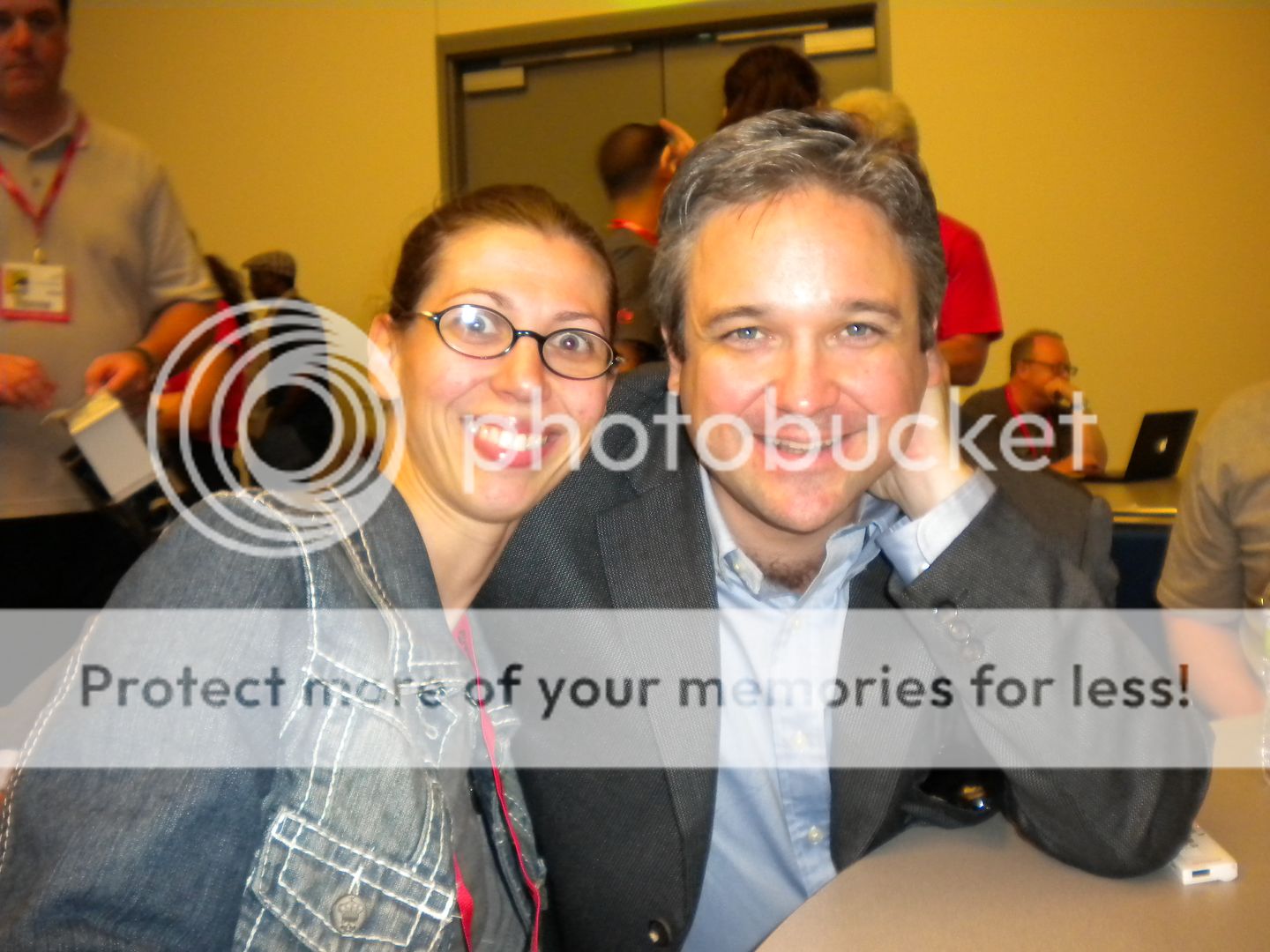
We started our time with executive producer David Eick with a humdinger—the question we know fans would want to ask. What has been the producers’ reaction to mixed reviews and fan division of the show, most notably from the Battlestar Galactica fanbase? “We knew to expect a much greater mix [of opinions] because we knew going in that we were not going to craft it or market it as a spin-off of Battlestar,” replied Eick. Rather than containing cheeky references to BSG or inside jokes only the audience knows, Caprica is very much its own beast. He hopes fervently that as the show finds itself and its own focus, that the audience, too, would find its own way in the show. He reminded us that the early days of Battlestar were equally contentious in terms of critical and fan opinions. “The very first Comic-Con we came to for Battlestar was like George W. Bush showing up at an ACLU rally.”
In many ways, he feels more challenged by Caprica, which lacks the ticking time-clock feel of BSG. It’s a more sophisticated style of storytelling, which is based in defining the characters and the world around then, Rome before the fall. The mythology of that world is deepened as the show progresses, and how it’s harnessed by Zoey to express herself. Eick spoke of how much more graceful and elegant Caprica is visually and content-wise, with Blade Runner being a huge influence on the producers and writers. By contrast, BSG had much more of a Black Hawk Down, action feel to it.
By the way, Ron and David have a longstanding tradition of taking a drink of tequila together before either a major show launch or major seminar/Convention. In fact, David brought the bottle and we all had a little fun. Kidding. But seriously, folks, next time you think the storylines on Caprica are getting a liiiiiiiittle wacky, just remember this picture:

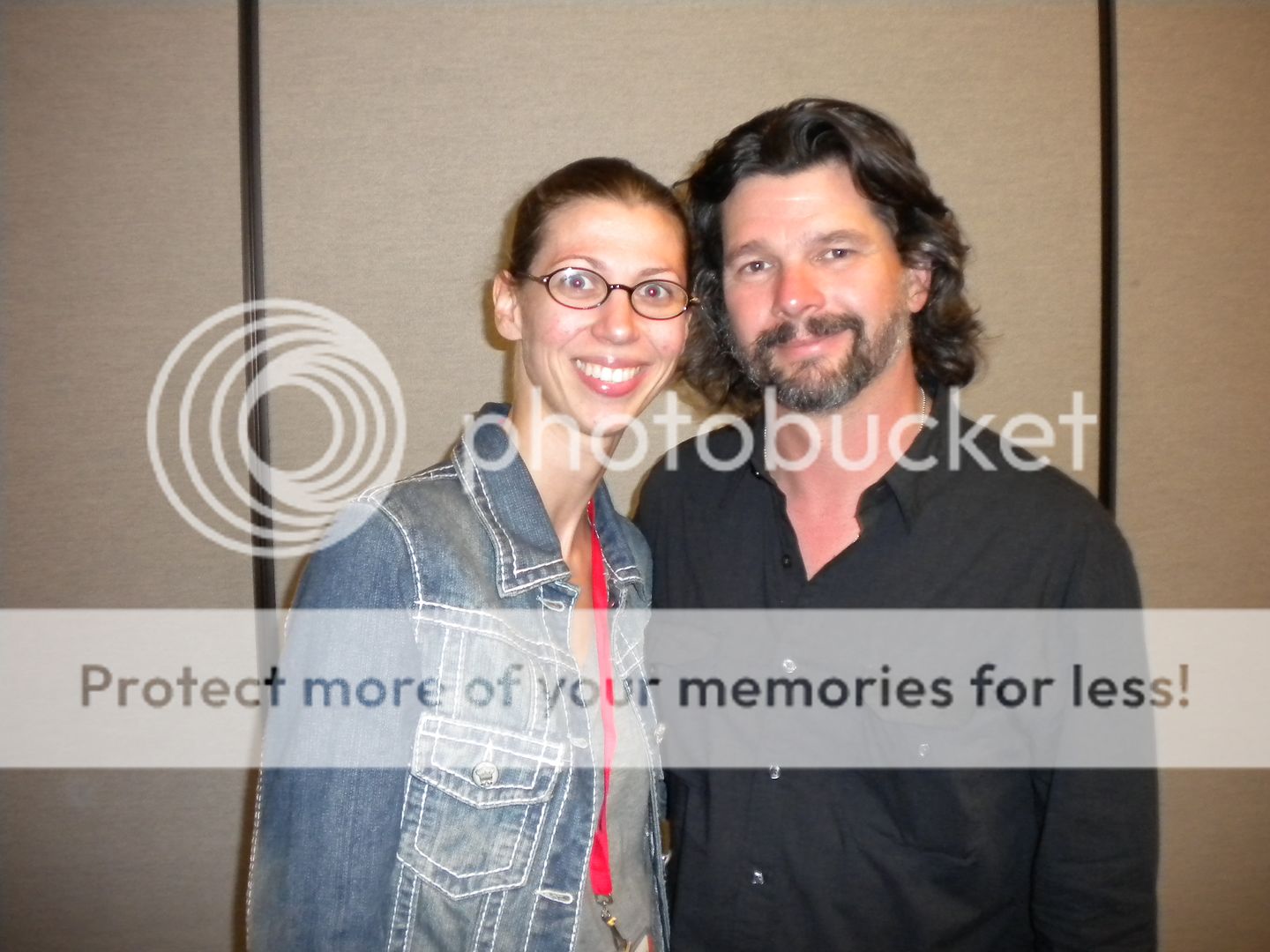
Ronald D. Moore, who made a rare media appearance at Comic-Con this year, largely echoed Eick’s comments. Caprica, he maintained is a serial, and (purposefully) as different from Battlestar Galactica as possible. In an even rarer move, Moore openly self-criticized himself for some of the early hiccups of the show. He admitted that it was hard to follow, that the story was indeed confusing, but that the show gained confidence as it went on. He predicted as strong of a build-up for Caprica as the eventual success of Battlestar Galactica. Another fun tidbit that Moore revealed was that the group marriage concept was tossed around for Battlestar Galactica, but just never found the story or the characters to make it happen.
We asked Ron about his thoughts on the current state of sci-fi and what he enjoys. “I’m probably not up to speed on a lot of other science fiction,” Moore said. “I almost avoid it now because I spend so much of my time in a science fiction world that I tend not to go there. It becomes almost like more work to watch other science fiction shows. In my brain, I’m inevitably thinking ‘How does that compare to us? And that’s their structure. How many characters do they have? I wonder what their CGI budget was.’ I haven’t watched a lot of other science fiction television for that reason.” Nevertheless, he maintains that it’s a thriving genre that will always be with us, despite the rise and fall of popularity. The one holy grail Moore hopes for is a broadcast network (read mainstream) sci-fi hit. He isn’t sure what the reason is that this popularity has remained so elusive, LOST notwithstanding. “Maybe it’s just us,” he mused. “Maybe it’s just us [the collective sci-fi geekdom], and there’s not this gigantic mass market for it in television in the way that there is a gigantic mass market for movies. Maybe that will never happen.”
We here at ScriptPhD.com hope otherwise.
From the Press Room: Big Bang Theory
If Ronald D. Moore is concerned about the viability of a basic network science fiction hit, at least he can take solace in Big Bang Theory, arguably the smartest, most successful, streamlined show about science and scientists in the history of television. We had such a fun time hanging out with the actors last year, that this year, with access to the full production team, we decided to get as much scoop from the show as possible.
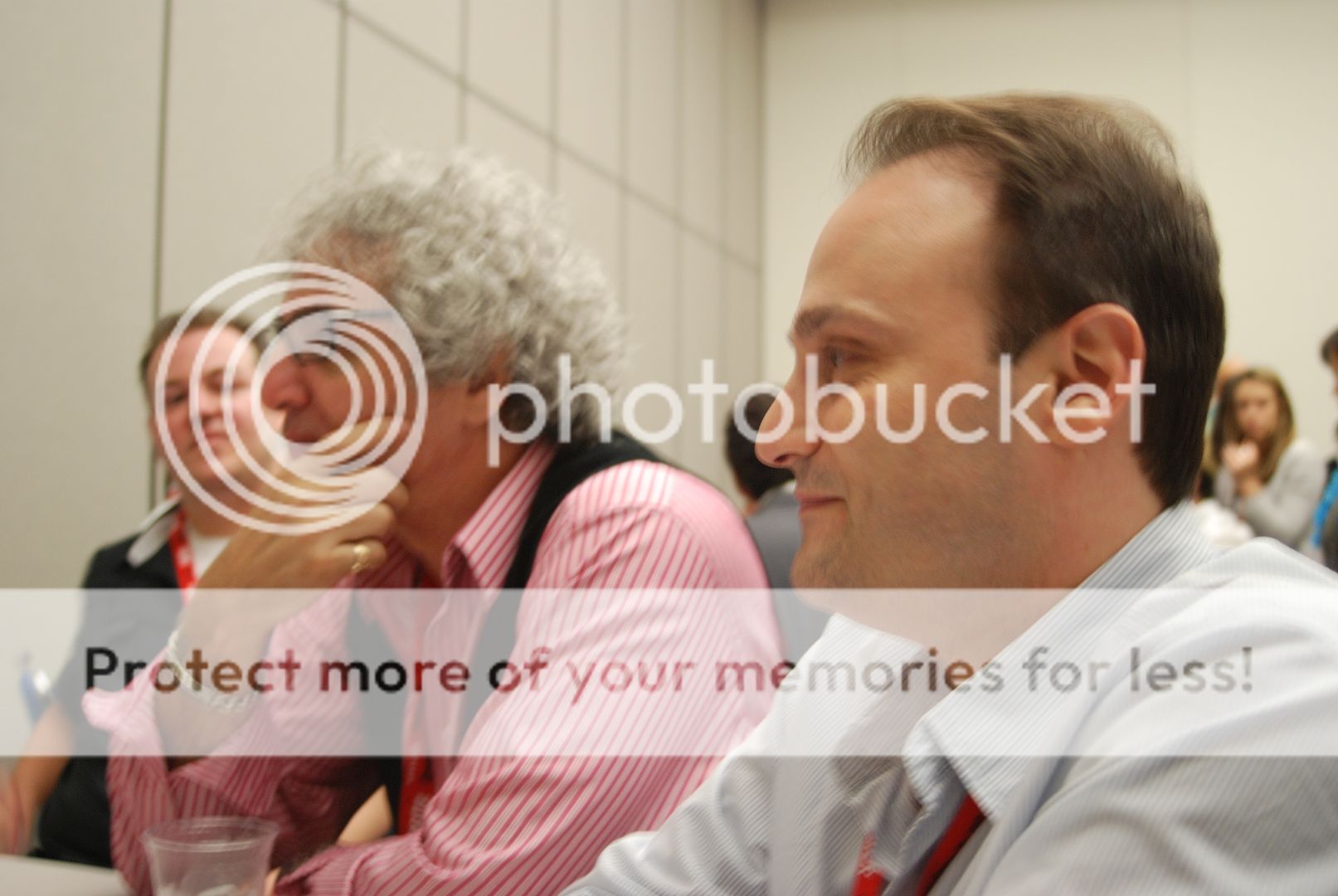

One thing fans would be surprised to learn, and the first question we asked right off the bat, is just how geeky the team behind Big Bang Theory is. Producer/writer Lee Aaronson, a self-certified comics and graphic novel geek, used to own his own comic book store. This is where a lot of the inspiration for Sheldon (and the rest of the team’s) love of geek culture comes from. They also have a close relationship to UCLA physics professor and the show’s science advisor David Salzberg. Often, they will write a line like “Hey guys, I was just working on [insert science here]” and let him fill in the blanks. We were wondering about that, too!
Geeky enough? Not even close. Showrunner and co-creator Bill Prady is a former computer programmer. He’s far more excited about Apple founder Steve Wozniak guest starring on the show than any fame or fortune that has incurred because of it. He and
co-creator Chuck Lorre maintained that the geek culture was their most important singular focus in writing the show. As one might glean from walking the halls of Comic-Con, they maintained that all geeks/nerds/scientists are not the same. There is a lot of heterogeneity amongst them, and differing, personal passions—be they Star Trek or the mathematical concepts behind string theory. And where do they get all their geeky throwaway lines? “Oh, those are all available on the internet!” And THAT is why we love Big Bang Theory.

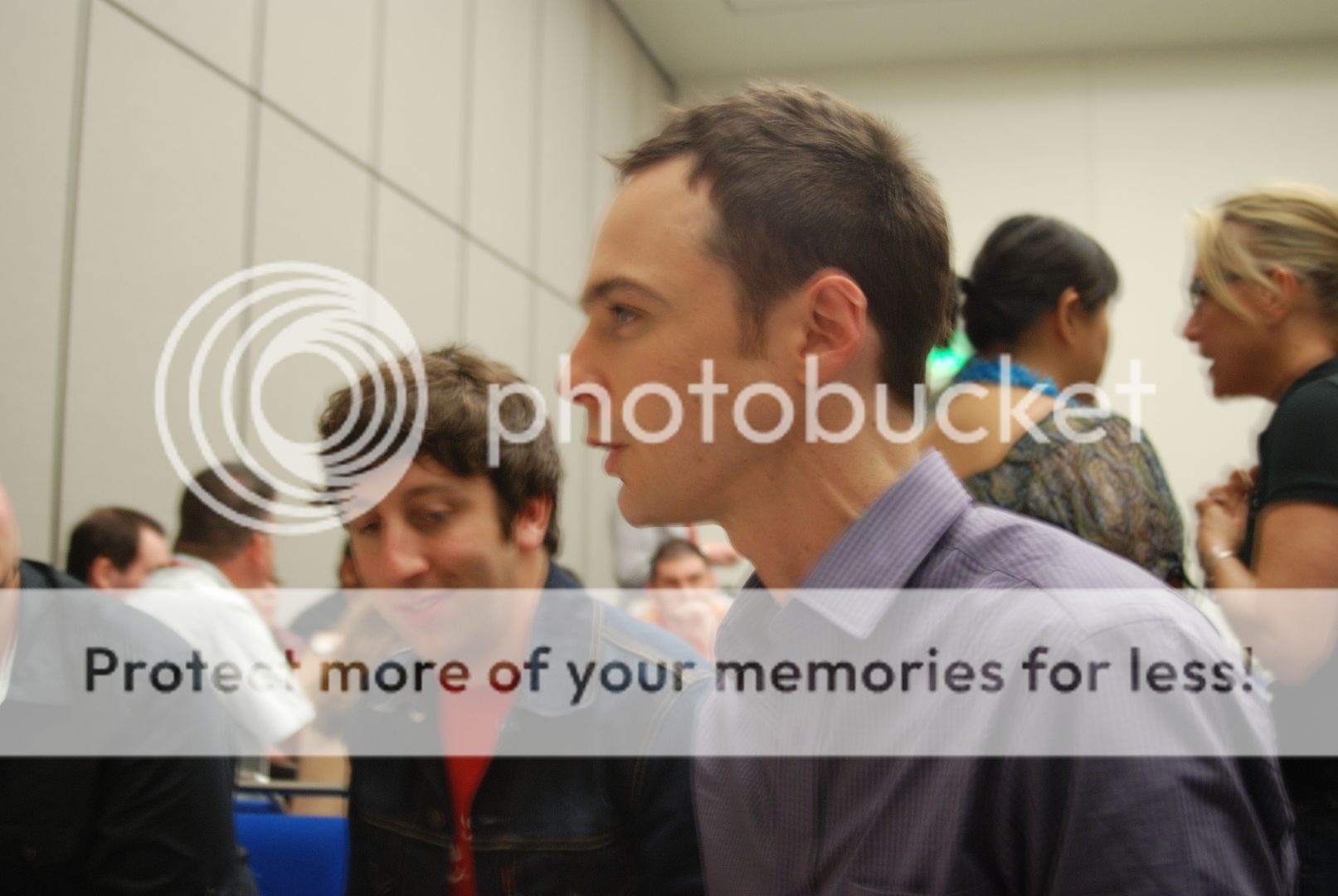
The actors themselves get right in the thick of the fun. Kaley Cuoco, playing perhaps the non-geekiest of the bunch in Penny, has nevertheless embraced geekdom. Her latest love? Her iPad! She and Johnny Galecki would both like to see a romance blossom between Penny and Sheldon (“Peldon,” joked Cuoco), but acknowledge that the road from platonic friendship to romantic involvement is filled with bumps and individual growth. Jim Parsons, who I shamelessly adore, started his time with us by telling me to shove it. He was, of course, talking about my tape recorder, but when I joked that I couldn’t believe Sheldon told me to shove it, his reply was: “And he’d tell you to shove it again and again!” Before telling Simon Helberg to bite him. Nice to know he stays in character so well!
We couldn’t leave a Big Bang Theory press room without getting our favorite superior elitist nerd to do something only for ScriptPhD.com fans. So here you have it, kids. From Jim Parsons, to you… a personal “Bazinga!”
Comics Design

One of THE most fascinating panels that we attended at Comic-Con so far was on the design secrets behind some of your favorite comics and book covers. A panel of some of the world’s leading designers revealed their methodologies (and sometimes failures) in the design process behind their hit pieces. An unparalleled purview into the mind of the designer, and the visual appeal that so often subliminally contributes to the success of a graphic novel, comic, or even regular book. We do, as it turns out, judge books by their covers.
We will be revealing each designer’s comments on their thought and art process, but are waiting for images from the panel to be emailed to us. So consider this a placeholder until we can finish this writeup and include it in Saturday or Sunday’s coverage. Stay tuned . . .
Graphic Novels: The Personal Touch
(From our correspondent Bryy Miller)

Some panels have mysterious names, some not so much. This one belongs in the latter category. There was no hidden meaning behind the phrase “personal touch.” This was all about the writers (Gabrielle Bell of Cecil & Jordan in New York, Howard Cruse of Stuck Rubber Baby, Vanessa Davis of Make Me A Woman, Larry Marder of Beanworld, Jilliam Tamaki of Skim, C. Tyler of You’ll Never Know, and moderator Shaenon Garrity of Skin Horse). More importantly and interestingly, it was about who they were. Some didn’t know who they were, others did, but they all knew one thing: that something inside of them needed to write.
Tamaki started off the discussion by stating perhaps the simplest answer of why she writes what she does, “I think that’s the only kind of book I wanna make.” Davis continued by adding that “anytime… it’s going to have a personal touch. Comics can soak up the people’s idiosyncrasies and sensibilities.” Marder, perhaps the odd man in the group, stated that even though his autobiography is a FANTASY, it still is an autobiography in the sense that it tells stories about his own feelings. Before anyone else could chime in, C. Tyler (arguably the oldest member of the panel) shot to life with an amazing amount of energy and playfulness. “I’ve taken autobiographies for granted.” she started “I know we’re at Comic-Con, but I hate superhero comics. When I read the first autobiographical comic, I was floored… it was disturbing and in a comic.” She went on to describe how she is fascinated with the idea of putting yourself out there, grabbing pieces of scraps from the table and showing us as if they were her life story – or even her creative process – in visual form. She would get extremely animated, and it really helped to humanize the element of the mysterious writer’s block and constant internal struggle to find how to portray your story. She ended her opening remarks with this, “the personal touch for me is I do it all by hand.”
Bell was the most reluctant to speak, but also, besides Tyler, the most visual. Not in the sense that she was very gesticulative or alive, but that she obviously was thinking very hard but having trouble in how to phrase her thoughts. “I try to cut my personal touch out,” she started, displaying the classic writer’s twitch of not looking directly at her audience “[I try to] make it universal. Professional.”
This instigated a very visceral response from Tyler, who on the spot tried to get into an earnest conversation with her fellow comic artist about what it means to be professional. Sadly, it didn’t last that long as Bell migrated back into thought. Cruse then brought up the point that, if your content is good, then mistakes in your craft are easily overlooked by a reader. The discussion (because calling it a panel at the end would just feel weird) had reached its time limit. Cruse gave some parting advice to young writers, “It will literally paralyze you to think of how many people have an idea similar to yours.” Marder stated that you have to fail in public. Garrity reminded everyone to heed that advice, as “Carol, Larry, and Howard have been in the comics since the seventies.”
Tyler let out a self-taunting gag.
Reign of the Dinosaurs

the Dinosaurs creative team (from left to right): Pete Von Sholly, Mishi McCaig,Tom DeRosier, David Krentz, Ricardo Delgado and Iain McCaig. (Executive producer Erik Nelson speaks on the jumbotron.)
In November of 2008, the hoi polloi at Discovery Channel approached producer Erik Nelson (Grizzly Man) with a simple request: “the ultimate kick-ass dinosaur show.” They poured enormous resources, creative and fiduciary, to create a television series that will truly break ground, both for Discovery Channel and its own medium. Scripted, yet unnarrated, scientifically stunning, yet bereft of the omniscient “talking head” paleontologist, Reign of the Dinosaurs is the ultimate exercise in “show don’t tell.” Premiering in the Spring of 2011, Reign will consist of 36 self-contained episodes erected from the art up. The stories will be chronological, detailing the rise, reign, and ultimate extinction (with a twist!) of the dinosaur species. But unlike the plethora of educational shows that cover the same topic, these will be rooted in storytelling, in treating the dinosaurs not as dinosaurs, but characters with whom we share an emotional connection. Trust me, having seen the first few world-premiere clips, you will care for these creatures, and the show will both exhilarate you and break your heart.
The true key to the success of Reign of the Dinosaurs was a dedication to amassing cream of the crop talent, formerly of Disney and Pixar, which allowed them to channel superlative animation and design talents towards an ambitious format. Along with Nelson, the team (and Comic-Con panel) consisted of renowned artists Ricardo Delgado (Dark Horse’s Age of Reptiles), Tom DeRosier (Lilo and Stitch, Mulan), self-proclaimed dinosaur nerd David Krentz (Disney’s Dinosaur, John Carter of Mars), Iain McCaig (Star Wars 1, 2, and 3), Mishi McCaig (Iron Man), Pete Von Sholly (The Mask, Darkman). Along with showing the audience their two (so-far) completed “cold open” teasers that will open episodes of the show, several of the animators simulated storyboard pitches (see picture below), just like the ones they would exchange in a writers’ room for several forthcoming episodes.

Several things impressed me upon the early viewing of Reign of the Dinosaurs, aside from the stunning art direction and well thought-out design. First of all, this show is really cheeky and funny. When the writers say that they’ll give the creatures personalities, they mean it, and it’s all done through expository action rather than showy narration. An early cold open has a dinosaur, trying to soothe her babies to sleep in the wee hours of the dawn, annoyed at the incessant chirping of a smaller dinosaur deep in the forest. Finally, she marches over and does what a dinosaur would do: bites the head off of her more annoying, diminutive co-habiting pest. Literally. Secondly, the stories pack an emotional wallop. A cinema-quality sequence shown at the end, taking place post-impact of the asteroid that ultimately killed off the dinosaurs, has the post-apocalyptic feel of Cormack McCarthy’s The Road (which the illustrator said influenced him) and visual appeal of Blade Runner. The ending, a hopeful coda on the extinction of the dinosaurs as an evolutionary stepping stone for our modern birds, had me sobbing. And then giving the panel a standing ovation.
Spring of 2011 is far away in television terms, but close enough for me to say this. Be excited, folks. Be very, very excited.
From the Press Room: Reign of the Dinosaurs

Not only did we get treated to a front-row preview of Reign of the Dinosaurs, ScriptPhD.com was extraordinarily fortunate to join the Discovery creative team for an intimate roundtable discussion panel after their panel. We were able to get enormous insight into the team’s collaborative process, storytelling aims, and dedication to balancing scientific accuracy with emotional connection, all while reinventing an entire medium. Ambitious? Just slightly.
One of the first things that impressed me upon talking to the Reign of the Dinosaurs team after their panel was their sheer dedication to, almost obsession with, “getting the science right.” Mishi McCaig and Iain McCaig spoke at length about the team’s dedication to nearing the line between science and entertainment. Hugely important to the project was the involvement of renowned University of Maryland paleontologist Thomas Holz, Jr., who cross-checks and gets pitched all the storyboard ideas. The behavior depicted in the show is speculative, but based on facts. This includes the animal’s muscle movements, how they would hunt prey, how they would interact—all aided by the paleontology knowledge of illustrator Dave Krentz. Ultimately, the team wants interest in the show to launch a more widespread educational initiative, which will include a Discovery multi-media website, and other supplementary materials to the show itself. Even when stories delve into the outrageous or fun, they’re rooted in research. A clip depicting high dinosaurs hallucinating was rooted in the marula tree, whose hallucinogenic fruit animals will eat and get high off of.
Producer Erik Nelson and illustrators Tom DeRosier and Ricardo Delgado spoke at length about the collaborative process of making the show, which they described like a TV writing room, only with animators. “Everyone’s sensibilities came together in a ‘hive mind’,” said Nelson. This visionary approach was important to the team, which is essentially trying to reinvent a TV genre. The last non-narrated, no-dialogue animated show was Walt Disney’s “Silly Symphonies” back in 1938. Needless to say, we’ve come a long way since then. The team was amazed at how constructing the dinosaurs’ stories moved them, comparing their effort to “March of the Penguins,” another simple vehicle showcasing animals that was rooted in an emotional audience response. This empathy for the dinosaurs peaks with the show’s conclusion, in which the dinosaurs die out (spoiler alert!), but which is still painted in an upbeat, survivalist way, as most geologists and paleontologists agree that modern birds are the direct evolutionary ancestors of dinosaurs.
“We’re not trying to hook you as a dinosaur person,” concluded Delgado. “We’re trying to hook you as a human being.”
Two last fun tidbits from today. Last year, on Day 3 of Comic-Con, we got geeky in the press room with our friend Barry of The Ugly Couch Show. When we saw each other again this year, we thought we’d start an annual tradition. So here it is, ladies and gentlemen. Two very tired, cranky, overworked press corps members getting silly in the press room:

And last, but definitely not least, is a very worthy Day 2 Costume of the Day. These ladies hit it out of the park. Bonus points if you can tell us which comics they’re representing:

Come back tomorrow for more geeky sci-fi fun! And don’t forget to become a fan of our Facebook fan page for extra Comic-Con photos and a chance to win amazing surprise swag when we get back from San Diego.
~*ScriptPhD*~
*****************
ScriptPhD.com covers science and technology in entertainment, media and advertising. Hire our consulting company for creative content development.
Subscribe to free email notifications of new posts on our home page.
]]>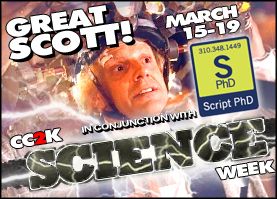
ScriptPhD.com is extraordinarily proud to present our first ever Science Week! Collaborating with the talented writers over at CC2K: The Nexus of Pop Culture and Fandom, we have worked hard to bring you a week’s worth of interviews, reviews, discussion, sci-fi and even science policy. We kick things of in style with a conversation with Professor Malcolm MacIver, a robotics engineer and science consultant on the SyFy Channel hit Caprica. While we have had a number of posts covering Caprica, including a recent interview with executive producer Jane Espenson, to date, no site has interviewed the man that gives her writing team the information they need to bring artificial Cylon intelligence to life. For our exclusive interview, and Dr. MacIver’s thoughts on Cylons, smart
robotics, and the challenges of future engineering, please click “continue reading.”
Questions for Professor Malcolm MacIver

ScriptPhD.com: Your first Hollywood science experience involved consulting for a sequel of the 1980s cult classic Tron. What was it like to dive in from the Northwestern School of Engineering onto a
set and work with screenwriters? What were some of your first impressions?
Malcolm MacIver: It was fascinating to learn a bit about how these huge expensive projects are structured. One specific thing I wanted to know more about was the role of writers in movies versus in TV. I had been told by friends in the industry that writers are typically less prominent players in movies than in top TV shows, were they can have considerable power. Consistent with this, we (the scientists who met with the Tron folks) were not introduced to the writers, who I believe were in the room taking notes, while we were introduced to all the other major players (director, producer, etc). I was also very curious to see how the group of scientists that I was a part of would interact with the movie makers. The culture gap is obviously huge, big enough for massive misunderstandings to blossom during superficially neutral discussions. During our meeting, our approach to the folks involved with the movie varied
from inspired to less admirable attitudes. The less admirable attitudes seemed to arise from the mismatch between the importance scientists can place on their own endeavors, relative to their endeavor’s importance to story telling.
An anecdote I like along those lines is about how the astrophysicist Neil deGrasse Tyson complained to James Cameron that when Kate Winslet looked up from the deck of the Titanic, the stars in the sky were in the wrong position. I liked Cameron’s response, which was “Last I checked the film’s made a billion dollars.” People love the story, not the positions of the stars above the Titanic. We all tend to overemphasize the importance of the thing we are closest to, and it’s a problem that scientists need to be especially attuned to in these contexts.
SPhD: You are now a technical script consultant for Caprica, the television prequel to Battlestar Galactica, providing insight into things like artificial intelligence, robotics and neuroscience. To date, what has been one of your biggest contributions to a final written episode that otherwise wouldn’t have made it in to the storyline?
MM: One of the themes of my research is understanding the ways in which intelligence is not just all about what’s above your shoulders. Nervous systems evolved with the bodies they control—the interaction is extremely sophisticated, and stubbornly resists our attempts to understand it through basic science research or emulation in robotics. Representative of this fact is that we now have a computer that can beat the world chess champion—a paragon of an “above the shoulder” activity—while we are far from being able to robotically emulate the agility of a cockroach.
One of the things we’ve learned about the cleverness that resides outside the cranium is that things like the spinal cord are incredibly sophisticated “brains” operating sometimes without much input from upstairs. Through some old experiments that are better not gone into, scientists showed that animals can walk with little brain beyond the parts that regulate circulation and breathing and their spinal cord. This is because the spinal cord can do most of what we need for basic locomotion without any input. The point is that control of the body is distributed—it doesn’t just live in the brain. The lesson hasn’t been lost on robotics folks; for example, Rodney Brooks popularized an approach called “subsumption architecture” based on this idea. So – back to Caprica: For episode 2, “Rebirth,” the show needed some explanation for why the metacognitive processor was only working in one robot. The real reason, as we know, is that only one had Zoe in it; but the roboticists were being pressed by Daniel Graystone as to why it wasn’t working in others. The idea that I gave them, which they used, was that it was because this particular metacognitive processor had distributed its control to peripheral subunits. Because of this, it had become tied to one particular robot. It’s an idea straight out of contemporary neuroscience and efforts to emulate this in robotics.

SPhD: To me, one of the most fascinating directions of the show is the idea that the first Cylon prototype was born of blood, in this case Zoe Graystone, and because of that, carries sentient emotions and thoughts. What is the fine line between a very smart, capable robot and an actual being?
MM: To vastly oversimplify things, you can imagine a gradation in “being” from a rock to a fully sentient self-aware entity. Some of the differentiators between the rock and you include things like the impact of others on how you think about yourself. For example, categorizing a rock as a particular kind of rock has no effect on the constitution of the rock. This isn’t so for self-aware creatures: once a person is labeled a child abuser, it actually affects the constitution of the person so labeled. People treat child abusers differently from non-child abusers. People who are categorized in this way suddenly see themselves differently; and those who were victims do so as well. The philosopher Ian Hacking, who I studied with during my Masters in Philosophy at the University of Toronto, called this the difference between “Human Kinds” and “Natural Kinds.” Another differentiator is that, for what you refer to as an “actual being,” there is a sense of self-interest in continued survival. Because of this, such a being is susceptible to being harmed, and may also therefore have what an ethicist would call “moral worthiness.” Moral worthiness in turn imposes certain obligations in regard to ethical treatment. For example, returning to the rock, we wouldn’t say we harm a rock when we explode it with dynamite, and we wouldn’t accuse the person who did the blowing up of unethical behavior (certain stripes of environmentalism would differ on this point). Unlike a rock, all animals exhibit an interest in self-preservation.
A very smart and capable robot can be imagined which is not affected by how it is categorized by others, and does not have an interest in self-preservation. So, it would fall short of at least those criteria for full-on “being.” But, there’s a lot more that can be said here, of course.
SPhD: What aspect of the Cylon machine and their story, which is now at the heart of Caprica, do you find the most captivating, either as a viewer or a robotics engineer?
MM: The scenario of our inventions eventually becoming so complex that they begin to have an interest in self preservation, and thus can be harmed (and so may start to be candidates for ethical treatment), is one I’ve thought a lot about in the past. It’s a key theme of the show, too. That’s one aspect that fascinates me about the show. The other is the play between the different kinds of being that Zoe has—from avatar-in-a-robot, to avatar-in-virtual reality, to “really real.” It’s a fun fugue on the varieties of being that raises good questions about the nature of existence and mortality, among others.
SPhD: In your latest post for the Science in Society blog, you explore the theoretical question of whether the United States (or any country, for that matter) could develop a Cylon type of war machine. Do you feel there is a distinct possibility the military might ever pursue this option and how might it impact warfare strategy?
MM: I’m going to explore that in my next few posts—and I’m still formulating my thoughts. In their initial development, a more realistic metaphor for how such robot warriors will work with us is something like a dumbed-down well-trained animal, willing to follow commands but without much of a sense of what to do if something gets in the way, and little recourse to things like flexibly generating new behaviors like a real animal does. But I can’t foresee any significant barriers to the development of autonomous robots with more of the attributes of a fuller kind of being I mentioned to above. I feel the more relevant question is whether this is on the order of 10 years away, or a hundred. Once it happens, the question will then be whether the global community recognizes military applications of this technology as a potential threat in need of careful control, like nuclear arms, or not. That’s all for now – for more you’ll have to visit my blog!

SPhD: During last year’s World Science Festival, we covered a really interesting panel called Battlestar Galactica: Cyborgs on the Horizon, which included a cross-section of engineers, ethicists and Battlestar actors discussing artificial intelligence, robotics, and the capabilities of modern engineering, which in some cases are very impressive indeed. In your opinion, what is one of the most significant or promising advance in robotics of the last few years?
MM: The maturing of what is sometimes called “probabilistic robotics.” This approach is what allowed the autonomous car Stanley to win the DARPA Grand Challenge, the challenge to have a vehicle drive itself with no human involvement over a challenging course in the desert. The basic idea is that while traditional robotics was concerned with making precise motions based on very well characterized inputs, what we need for robots to work in the real world is ways to handle the massive array of noisy and uncertain signals that are typically available to guide behavior. There are approaches from probability and statistics for doing this well. These approaches are integral to making robots have greater sensory intelligence. My own laboratory has developed a new kind of sensory robot using this approach, and it works very well.
SPhD: I have previously argued that television and film do more for promoting science by incorporating small, accurate pieces into an overarching story rather than basing an entire story on an unsustainable or far-reaching scientific concept. Thoughts?
MM: TV and film, when it is successful, is about telling a captivating story. The elements of good story telling (emotional connection to the characters, humor, insight into what it is to be human) have little in common with the elements of a good scientific concept (testability, explanatory power, coherence with the rest of what we know). So, yes I’d agree. Trying to do more than incorporate small bits is going to lead to your audience feeling like they are getting a lecture rather having a story shared with them, and no story teller should do that. Documentaries are an interesting hybrid, though—you need a good story, and if it’s about science, a good bit will be on the concepts. How to make that exciting and not spin out into yawn-provoking pedantry is quite the trick.
Malcolm MacIver, PhD, is a professor at Norwestern University with joint appointments in the Biomedical and Mechanical Engineering departments, and an adjunct appointment in the Department of Neurobiology and Physiology. He received a B.Sc. and MA at the University of Toronto, and a PhD in Neuroscience at the University of Illinois in Urbana-Champaign in 2001.
~*ScriptPhD*~
*****************
ScriptPhD.com covers science and technology in entertainment, media and advertising. Hire our consulting company for creative content development.
Follow us on Twitter and our Facebook fan page. Subscribe to free email notifications of new posts on our home page.
]]>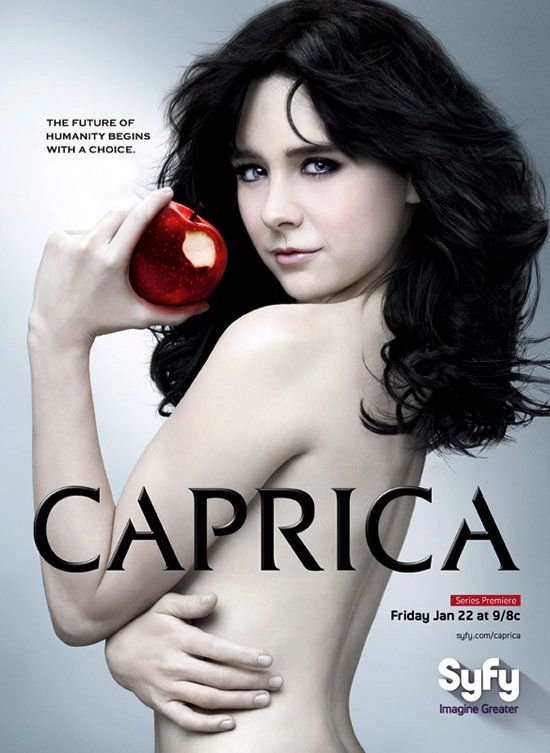
No one has been more excited about the premiere of Battlestar Galactica prequel Caprica than ScriptPhd.com. We eagerly joined the cast and crew of both shows last May during their joint panel at the Los Angeles Paley television festival. We were also one of the first sites to review the Caprica 2 hour pilot. And now, at long last, one of the most anticipated sci-fi prequels ever will premiere on the SyFy Channel this Friday. ScriptPhD.com’s Bryy Miller reviews the first three episodes and talks about the show’s early conceptualization and long-term promise. We are also extraordinarily fortunate and proud to bring you an Editor’s interview with series executive producer and show runner Jane Espenson, in which she talks about what we can expect from Caprica. Please click “continue reading” for full content.
REVIEW: Caprica
ScriptPhD.com Grade: B
The spin-off of SyFy ratings spectacular Battlestar Galactica has a lot in common with Shakespeare’s King Lear. Like King Lear, it is far more ambitious than any of Shakespeare’s previous works, both in scope and in depth (yes, even more so than Hamlet—but that’s for another article). In addition, it fleshes out the ensemble on a level far more fluid and psychological than what came before. But, as it turns out, being like King Lear is Caprica’s great flaw. The glitch, so to speak.
Caprica, for the benefit of new fans, is a follow-up to writer/producer Ronald D. Moore’s ambitiously verbose and successful science fiction series, Battlestar Galactica. Caprica’s main mission is to tell the creation story of the being that would one day become mankind’s greatest enemy, an artificial intelligence called the Cylon. Unlike other AI, these robots actually experience emotion and lead “full” lives. This, of course, will make for some rather interesting debates on the nature of intelligence, the soul, and war in general. Caprica takes place approximately 58 years before the events of Galactica, and while my brain is not scientific enough to compute if that is a short enough time span to encompass the full sequence of events, from the looks of it, they seem to be going at a realistic pace. In those 58 years, the Cylons don’t just sit around on the assembly line: they have to gain sentience, be mass produced, become a staple of everyday life, and start the FIRST Cylon war with humanity. Because there is quite a lot of story to tell, the central question is not whether the series is sustainable, but whether the story is worth telling.
Back to the Lear analogy. The thing about BSG was that, even though it possessed quite a large ensemble cast, it was plot-driven. Each character was essential to one overarching story, one goal. Caprica is not plot-driven. It is character-driven, and this is where it becomes a liability to be just like lil’ old King Lear. The writers of Caprica seem content to throw a lot of disparate characters all over the map doing completely different things and interweaving story arcs that feel as if a silk spider had gone to work on them. “It’s more about their personal lives,” admitted series creator/writer Jane Espenson at last year’s Paley event. “They don’t have the threat of death breaking down their neck every moment so that you can feel more lived in, you can explore this culture more.” Added Ronald D. Moore, “It’s a different show. I mean, losing the action-adventure is a risk…. [But] since there’s no Cylons coming in to sort of destroy the Galactica every once in a while, fate and humanity doesn’t hang in the balance yet.” Caprica writers even go as far as to make the main antagonist a polygamist, and give her family life a (sometimes bloated) spotlight. It’s as if they thought simply giving a character something to do would be high drama. Don’t even get me started on the subplot involving what seems to be an entire precinct of corrupt cops, three of which are introduced as part of the ensemble. My fears were not assuaged one bit when I saw that Ron Moore himself was on the writing staff. It may seem contradictory, me saying Ron Moore, the creator of a brilliant generation-defining show, writing for Caprica might be a bad thing. While he does a mean tap dance, Mr. Moore has a tendency to introduce plots into his shows without knowing what they have to do with said show. This is most apparent when he copped to not knowing where a pregnancy storyarc in BSG was going (among a human and Cylon, no less), and when he flat out stated that you don’t know where a season is going to end when you start writing it. This began many debates within the writing community if having a planned story versus on-the-fly writing mattered (the answer is, and always will be, yes). While initial publicity seemed to indicate that his involvement would be minimal, for Caprica’s sake, hopefully it is the Ron Moore of the earlier stages of Battlestar Galactica. It helps that the show is being helmed and written by equally brilliant BSG and Buffy the Vampire Slayer writer Jane Espenson.

Our story begins with Daniel Graystone (Eric Stoltz), genius inventor, man about town, owner of seemingly everything. He is Bill Gates 2.0, and unbeknownst to him, his daughter Zoe (Allessandra Torresani), is busy creating artificial life in the form of a digital clone. The very first scene in the series is also the most confusing and frustrating, because it takes place in an Internet 8.0 lab of hers. Picture a fully interactive Second Life, overpopulated with the bored, the rich, and the dumb—which is not fully explained to the viewers in any coherent manner for at least thirty minutes into the two-hour pilot. There is a lot to like about Caprica. Every single concept in Caprica’s world was superb. Amazing. Despite visual and thematic superiority as one would expect from the BSG team, there were problems with early conceptualization. Everything seemed to be told to the viewer three times: once in vague technobabble that is supposed to sound too smart for us, once in a truncated layman’s speak, and yet another in a sort of mystic and supernatural definition. The problem is not with the idea but with its execution. Zoe’s invention—the Amoeba of the Cylons—is basically a search engine that can find genetic data and turn that into… well… memory. RAM. Gigahertz. It’s a fantastic way to explain true AI, the only problem is that the writers do so through the steps outlined before.
Tragedy occurs. Telling would be spoiling, but needless to say, Zoe dies in an accident that not only takes the life of the daughter of Joe Adams (Esai Morales), father of Galactica’s future commander Bill Adama, but also stirs the show’s significant dialogue on monotheism and the Cylons’ embrace of a One True God. Joe will come
into Daniel’s life later, but not before Zoe’s digital avatar says she felt Zoe die. It’s a Christmas Miracle. Daniel discovers this and is torn between being with his daughter once more and exploiting his dead spawn’s technological breakthrough to save his own dying company. Coinciding with Zoe’s death is a ticking clock on a government order for a perfect war machine robot, a hitherto failing experiment. It seems that Zoe 1.0’s death has caused a chain reaction resulting in a steady drop in shares, and the ire of Baxter Sarno (Patton Oswalt), a talk show host that has got to be the love child of Don Draper and Conan O’Brien.
Joe Adama’s story is one of woe from even before the mysterious accident. Adams is a Tauron, an ethnicity most despised out of all the horoscope-based groups of the Caprica/BSG universe. Joe resides as a lawyer in what is a Caprica take on Little Italy in the 1920s. I really loved these scenes, of which there are plenty, and could honestly watch the rest of the series—flaws and all—to its end simply for them. Joe’s brother is in the mob (another mobster looks strikingly similar to one of the 12 human Cylon models, FYI), teaching young Will Adams “street skills” that obviously and ultimately help make him so tough later on; Joe himself is in constant war over being a straight lawyer or being on the payroll. Indeed, at the end of the third episode, he does something so over-the-top that it risks making him seem unbelievable. Coming back to his ties to Graystone, he has a brilliant line about wanting to jump off a bridge that he says to the man during their initial meeting. In fact, both men do tremendous jobs of suffering incomprehensible pain for more than one episode, which I liked. Too many shows blithely brush off important deaths, or death in general. The two men become intertwined, first by loss, then by ideology. Even in conflict, they keep circling each other. But viewers lulled into thinking this is a simple “buddy” arrangement are dead wrong. Sometimes Greystone and Adams like each other, sometimes they don’t, but they always feel like they exist without the other. Graystone lets Adams in on his little “secret”, and their worlds crash into one another like a preordained destiny.
Zoe 2.0, it goes without saying, is the cornerstone of Caprica. No matter what else fails about the show, the ideas and concepts behind Zoe 2.0 shine through. Because Zoe 2.0 was “born” through blood, we get an interesting twist on the idea of violence being inherited; this time, however, it is digital inheritance instead of pure genetics. Because Zoe’s mother, Amanda (Paula Malcolmson), never knew her daughter in life, she has the possibility of getting to know her in death (this never happens in the first three episodes, but it is hinted that they will go down this road in some form). Male tech geeks unwittingly poke and prod at Cylon Zoe 2.0 when daddy downloads her in a prototype robot body, most likely commenting on how we objectify women in our society. Zoe’s “brain”, after being linked to her robot body for a limited time, refuses to work in other bodies, much like an organ being rejected. There’s also a hilarious scene involving Zoe 2.0 in the proto-Cylon shell which will forever be hailed as the ultimate walking-in-on-your-parents moment. Time will tell if these will remain brilliant and worthy science fiction concepts, or if they will be supplanted by other stories as the series evolves.
Overall, one would expect Caprica to have been a bit more polished, especially coming from the purebred creative stock that it is derived from, but it’s a pretty decent start to a prologue. Regardless of the flaws in the writing and story structure, Caprica has enough going for it to be at least a casual watch with a cult following from the previous series. It won’t be as good as people say, but it won’t be as bad as they say, either. Which is enough like King Lear as you can get, acclaim-wise.
Caprica airs on the SyFy Channel, Fridays at 9pm, premiering January 22, 2010
The cast and crew of Caprica preview what to expect in the show, and their world:
Interview with Battlestar Galactica writer and Caprica showrunner Jane Espenson:
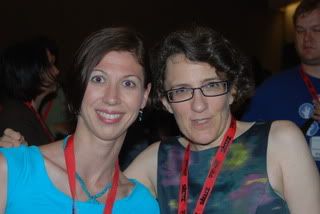
ScriptPhD.com was extraordinarily grateful to the SyFy Channel and Jane Espenson for granting us the opportunity to ask a few preview questions. We wanted to ensure ScriptPhD fans’ questions got answered and that we could bring you exclusive scoop that you can’t find on any other site. Here is what Jane had to say about the show, her career, and a look back at BSG:
ScriptPhD.com: A lot of fans know you from your brilliant work on Buffy the Vampire Slayer, The Gilmore Girls, and most recently Battlestar Galactica. But what a lot of fans don’t know is that you had a most atypical entry point into the Hollywood scene. You studied linguistics at UC Berkeley, both as an undergraduate and a graduate student, with some very impressive academic achievements before getting noticed for your Star Trek: The Next Generation spec script. How do you feel that the rigors of academic study prepared you for Hollywood, writing for TV, and now, being a showrunner?
Jane Espenson: Wow, interesting question — I have no idea if it’s going to lead to an interesting answer, but let’s give it a try! My graduate work was in a very specific part of Linguistics/Cognitive Science — I studied metaphor, not as a literary device, but as an important part of how we conceptualize the world around us. In a way I suppose it’s a very science fictiony area of study because it’s all about the ways our brains translate our abstract interactions with the world into OTHER kinds of interactions with the world. There’s something very “V-world” going on even inside our own brains, to use some of the parlance of Caprica. The climate of inquiry and open-mindedness that I encountered in school is very much like what you find in the writers’ room of a science fiction television show. And, of course, science fiction is inherently about metaphor — understanding our world by filtering it through a different set of rules. There are days in which what I did in school feels very separate from what I do now, and days in which it feels like I never left — like it’s all part of the same inquiry. But now I get to write for robots!
SPhD: This is a Battlestar Galactica: The Plan question from our fan Grey. He brought up the interesting point that the Cylon John Cavil has one of the most fascinating, perplexing roles in this movie (and arguably the Galactica story). His character seems to contradict himself philosophically and morally a lot. Just as the Cavil on Caprica learns to trust from Anders and the Resistance, the Cavil on Galactica seems to learn not to trust from Ellen and the other Cylons. Indeed, the Caprica Cavil has a point blank shot at Starbuck and he doesn’t kill her, but viciously knifes the little boy that befriended him on the Galactica ship. Do you have any thoughts on this?
JE: Yes, exactly — the two Cavils go on different journeys that lead them to diverge. The Cavil on Caprica learns a lesson that the Cavil in the fleet doesn’t learn. Caprica-Cavil learns that the love for humanity is going to survive even if humans themselves don’t. He doesn’t take the shot at Kara and he comes to view the entire attempted genocide as a massive error. Fleet-Cavil has other experiences in which the Cylons who surround him are repeatedly rendered useless by the affect humans have on them. When even he starts to feel the appeal of humanity, he lashes out at the orphan boy. He steels himself against humanity and his views become more and more unforgiving. By the end of The Plan, the two Cavils have very different opinions on the actions they’ve already taken, and what they should do next. Events of the end of the BSG series tell use which position was adopted by the other Cavils. (It wasn’t the more loving one.)
A Caprica question from another fan, Iqbal. He wonders if the show Caprica will explore moral ambiguity not just in surface concepts, but really try hard to pull topics from our own contemporary struggles (two wars, religious conflict, health care, the failure to engender proper economic reform, etc) in ways that defy the superficiality of the mainstream media as well as explore historic issues — as some of your best collective work on BSG did?
JE: We made a real attempt to make sure we were writing episodes, not essays. But, yes, absolutely, matters of religious conflict, abuse of government power and cultural bias are so thoroughly cooked into our show that the episodes inevitably explore these issues. And moral ambiguity is really the key to the show. The characters on our show tend to believe that their personal values are the key to keeping their world from sliding to its destruction, so they’re all driven by highly moral principals from their point of view, which may not be at all the view of the other characters or of the viewers. This was really exciting stuff to write. So yes, we do address contemporary issues, but we don’t bend the show around to focus its lens on the issues — we let it occur naturally as the stories take us there.
SPhD: A really fun Caprica question from our fan Josh! In the Caprica pilot, we saw the END of a professional pyramid C-Bucs game where they left the court….is it possible the writers might incorporate an actual Pyramid game for us to see on Caprica?
JE: Yes! We will see parts of games. It turns out that large arenas, and more importantly, large crowds are very expensive to film, but you will definitely see and hear some game play. Both the team and Atlas Arena itself will be very important to our story as it unfolds.
Film director and screenwriter Bryy Miller is the president of Lefty Films.
~*Yorick Archer*~
******************
ScriptPhD.com covers science and technology in entertainment, media and advertising. Hire our consulting company for creative content development.
Subscribe to free email notifications of new posts on our home page.
]]>
